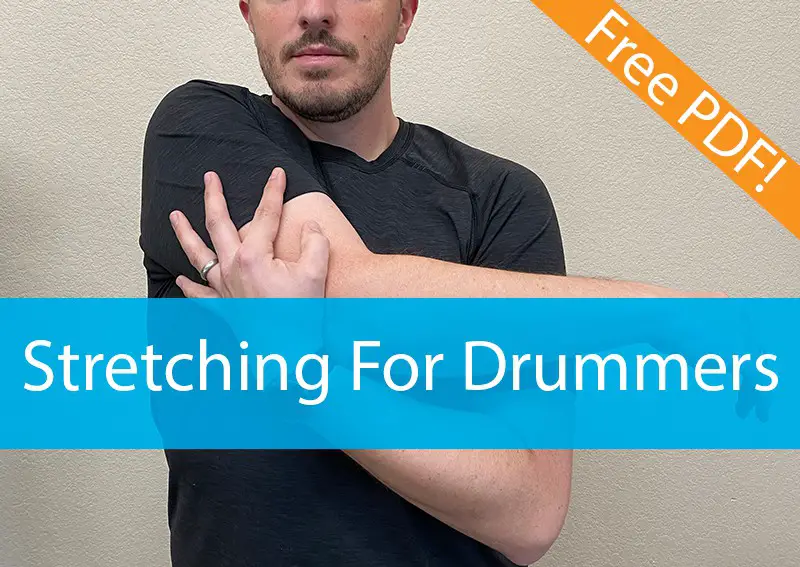
There was a long stretch of my life (pun intended) where I practiced relentlessly; probably five to six hours per day! I could not have sustained that schedule without taking care of my body in the form of exercise – but also in stretching to avoid injury. As such, I thought it would be good to share with you the stretches I do before practicing (and a few related tips) to keep you in tip top shape.
This is a list of stretches commonly recommended for drummers. What follows are detailed instructions and photos to help you perfect these movements. I’ve also taken it a step further to include other stretches beyond just the upper body to ensure your entire body is ready for some serious shedding.
- Warm Up
- Shoulder Blade Squeeze
- Cross Body Should Stretch
- Shoulder Stretch with Sticks
- Fist Stretch
- Hands and Fingers Stretch
- Wrist Stretch
- Arm Shake-Out
- Lower Back Twist
- Knee Huggers
- Leg Swings
- Heel Drop Calf Stretch
- Shake It Out
Before we continue…
I do want to address a couple of items related to your new stretching routine to ensure you get the most out of every movement:
- EVERYONE HAS A DIFFERENT BODY:
Because of this, you may decide that you need to stretch more in a particular area. That is perfectly fine! Do what feels good to you. If you start playing and you consistently feel tightness in a certain area of the body – by all means increase your stretch time. - DON’T HOLD IT (STATIC) – MAKE IT FLUID (DYNAMIC):
Instead of holding a stretch for a long time (static stretching), opt for a more fluid and repetitious stretch, also called dynamic stretching. It has been shown that holding stretches can actually cause muscular and tendon damage, especially if your muscles aren’t warmed up. - START WITH THE ‘BIG STUFF’:
I like to start by stretching my larger muscle groups first before moving on to my smaller muscles. This has the added benefit of making it easier to memorize the routine. - WARM UP FIRST:
It may seem counterintuitive, but stretching while your muscles are cold isn’t as effective and could be dangerous! See section one below. - GET THE FREE QUICK GUIDE!
I’ve taken all of the concepts in this article and condensed them into a downloadable PDF, which you can grab for free at the end of this article.
OK – Ready!? Here we go! Let’s start with the upper body:
Warm Up
Fact: Stretching completely cold muscles can actually lead to injury. The good news is that this is quite easy to avoid by simply warming your body up with some form of exercise for 2-3 minutes. I would suggest one of the following:
- Light jog
- Jog in place
- Jump rope
- Climb a few flights of stairs
The key is to get your heart rate up a bit and to try and utilize the majority of your body. Another side benefit is that your breathing will likely increase as well, which will help to oxygenate your blood in preparation for working out!
Shoulder Blade Squeeze

This is a great first stretch that will open up your chest and start to get some blood flow going across your entire upper body. Follow these steps to properly complete the stretch:
- Start in a natural standing or seated position, with your arms comfortably resting at your sides.
- Ensure that you relax and drop your shoulders before you start.
- Slowly squeeze your shoulder blades together. Imagine that you are trying to pinch a piece of paper between them.
- Hold for 4-5 seconds.
- Repeat 5 times.
Cross Body Shoulder Stretch

You will have likely done this stretch before if you’ve ever participated in any sort of sporting activity:
- Cross one arm over the front of your body, almost parallel to the ground.
- Using your free hand, reach over and grab your stretched shoulder.
- Gently pull it towards your extended arm.
- Repeat with each shoulder 4-5 times.
QUICK TIP: This is an example where dynamic (instead of static) stretching should be utilized. Do so by gently increasing and decreasing the pressure with your opposite hand, creating a rocking motion. Also – don’t hold any one side too long.
Shoulder Stretch with Sticks
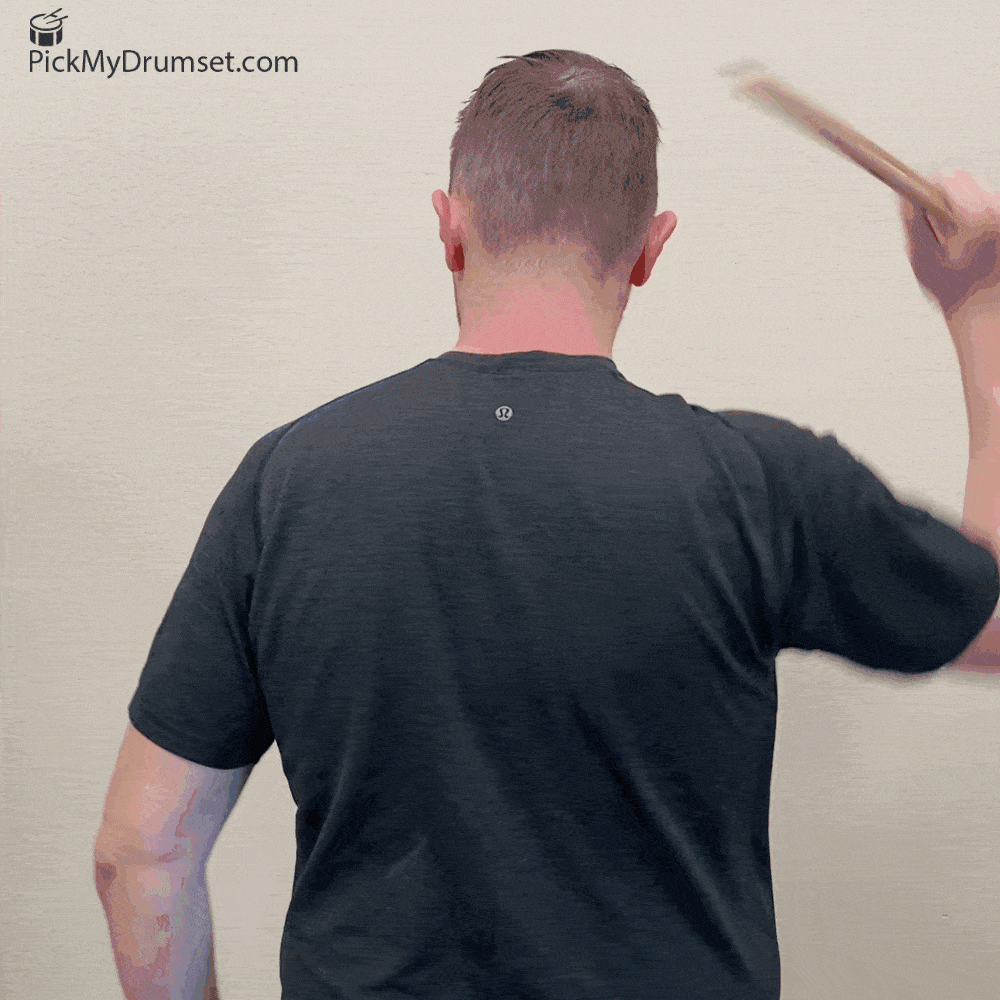
This stretch is what separates the drummers from…well…the non-drummers. It feels great, especially after having completed the previous exercise:
- Grab a pair of drum sticks.
- Hold both sticks in one hand.
- Swing that hand up and behind your back so that your sticks are pointing straight down.
- Grab the pair behind your back with the other hand.
- Pull down using your lower hand, feeling the stretch in your shoulder.
- Again, utilizing a dynamic stretching technique here is favorable.
Fist Stretch

With this stretch, you are starting to engage your hands and forearms:
- Start by making a fist with both hands simultaneously.
- Ensure that your thumb is on the outside of your fingers.
- Then, open your hands as far as they will go. You should feel this stretch throughout your hands and wrists.
- Repeat 3-4 times.
Hands and Fingers Stretch
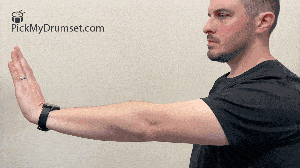
Now we are getting to the good stuff – the hands!
- Start by extending one arm straight in front of you, with your hand up and palm facing away from you.
- Grab your fingers with your free hand and pull them gently back towards your face.
- Now, point your fingers to the ground so that your palm is now facing you.
- Again with your free hand, grab your fingers and gently pull them in towards you, being careful not to go too far.
- Repeat this sequence twice with each hand.
Wrist Stretch

This is an important stretch NOT to over-extend, but done correctly can open up your wrists nicely in preparation for playing:
- Hold your arm straight out away from you.
- Rotate your arm and bend your wrist so that you can see your palm in front of you.
- With your other hand, gently rotate the hand to be stretched outward.
- Hold for a few seconds and release.
- Repeat with each wrist 2 times.
Arm Shake-Out
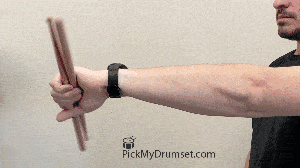
Now that you’ve thoroughly stretched your arms and hands, let’s shake it out a bit:
- Grab two sticks and put both in one hand.
- Hold your arm straight out in front of you, but in a somewhat relaxed manner.
- Rotate your wrist back and forth while holding the sticks in relatively quick succession.
- Repeat with each arm 2-3 times each.
- While you’re at it, you might as well pretend that you are a propeller airplane and make engine noises.
Now…let’s focus on our lower extremities a bit. I am typically most concerned about my back, hips and calf muscles, as those are the lower body muscle groups I use most consistently when playing drums.
Lower Back Twists
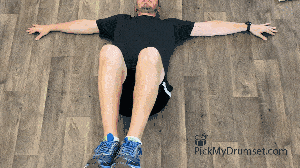
To get started on stretching out your lower muscle groups, start with a nice back stretch. I love this one because it feels good and is actually quite relaxing:
- Lie down on your back, with your knees bent and feet flat on the floor.
- Lay your arms out to your side in a ‘T’ position, which will help keep them out of the way of your legs, but also provide you with some stability.
- Start easing into this stretch by first just rocking your knees back and forth about 20 degrees in each direction, left to right. Engage your core while doing so for stability. This will help you start warming up these muscles.
- Next, gently drop your knees to one side. Make sure your opposite shoulder still touches the ground. If your knee doesn’t make it all the way to the ground, that is fine.
- Hold for 15-20 seconds.
- Repeat on the other side.
Knee Huggers

While you’re already laying down, you might as well do a couple of knee huggers. These super simple exercises further stretch out your back while also opening up your hips:
- Lie down on your back with your knees bent and feet flat on the floor.
- Bend one of your knees and grab it with your hands, just below the knee cap.
- Gently pull your leg into your chest, ensuring that you keep your hips and other foot planted on the ground.
Leg Swings
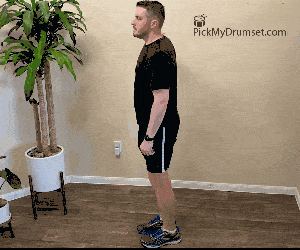
You’ll see a lot of runners doing this exercise, mainly because it’s a great way to open up your hips and get blood flowing in your legs:
- Unless you have the balance skills of a ninja, I would recommend you find something to hold on to while you are doing this exercise.
- Start in a standing position.
- Swing your leg forward as far as is comfortable and then back behind you.
- Repeat 8-10 times with that leg.
- Repeat with the other leg.
Heel Drop Calf Stretch
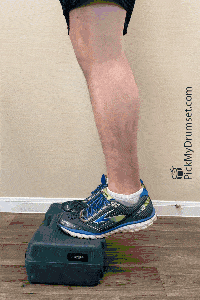
This is what’s called a ‘gravity assisted stretch’ because you use the benefit of gravity to pull on the muscle in question. As with most of the other stretches we’ve discussed, you’ll definitely want to use dynamic stretching here:
- Find some sort of raised platform; either a block, a curb, or the edge of a drum riser to stand on.
- Make sure the balls of your feet are near the edge of your raised surface, so that your heels are hanging off the edge.
- Lower the heel of one foot while bending the knee of your other leg.
- Try to keep most of your weight on the leg being stretched out.
- Repeat with each leg 5-6 times each.
- To keep your stretch dynamic, create almost a pedaling motion as your shift your weight between feet.
- It is always a good idea to have something to hold on to while you’re doing this stretch to keep you stable.
Shake It Out
After all of this warming up and stretching, you should be good to go pick up a pair of sticks and start your warm up routine. BUT BEFORE YOU DO – get a little silly and shake your whole body out.
Depending on your environment and how much you value your image, you can opt for the whole body crazy shake – or the more modest “shake one limb at a time ’cause I’m cool” shake. Your choice.
Some Words About Exercise For Drummers
Often overlooked, but equally important to your efficacy as a drummer and an excellent way to avoid getting injured is to make sure that you are also focused on exercising your body to build up key muscle groups and stamina.
Over the years, I’ve tried many different forms of exercise and I won’t go through all of them here. What I will present you with is those forms of workout which have had the most positive impact on my playing throughout the years.
Yoga practiced regularly can be truly transformational to your body and your life. With regard to drumming in particular, Yoga is great because it is a truly full-body workout and toning exercise. Additionally, yoga can be an artistic expression as well, which is great because it will help exercise your peace of mind and expressiveness as an artist.
Weight Training is beneficial in so many ways as a drummer as it builds up your stamina and also helps with dynamic control. I’m not saying you have to go to the gym all the time and get completely ripped, but the proven physiological benefits of weight training combined with healthy eating can do wonders for your playing abilities.
Building Up Core Strength this goes hand-in-hand with both exercise types above, but I think deserves special mention because it informs everything you do physically, not only behind a drum kit but in life as well! Regularly doing crunches, situps, planks, back exercises, etc. will help you maintain good posture and balance behind the kit, which is especially important for great foot pedal control.
Grip Strength Training is something which I wouldn’t necessarily classify as exercise as it likely won’t raise your heart rate. Nonetheless, it can help you to strengthen your fingers which in turn will help you with stick and finger control. Go get that stress ball!
Jump Rope is probably one of my favorite exercises as it is a full body workout, but doesn’t require a ton of space or equipment. Jumping rope, even for 15 minutes is quite an intense workout if you’re just getting started – and so by doing it regularly you are also increasing your stamina behind the kit.
I hope these suggestions for exercise help you get some ideas for what can benefit your playing as well.
Nutrition and Hydration
The two go hand-in hand, but please don’t ignore these aspects of a healthy lifestyle as everything we are talking about in this article will benefit from you taking care of what goes into your body.
Keeping hydrated with lots of water has definite benefits to your performance level. Additionally, eating clean, nutrient-rich foods help maintain mental clarity and proper muscular nourishment. If you’re unsure what Clean Eating entails, there are many publications out there that can detail it for you.
That said, eating on the road can be extremely challenging as the source of your food can be quite out of your control sometimes. All I can say is – I’ve been there. It’s hard. But do your best. Your body and your playing will thank you.
Don’t Forget The Warm Up
Stretches are essential to keeping your body healthy and balanced, but just because you’ve stretched, doesn’t mean you shouldn’t warmup on a practice pad prior to playing.
IN FACT – I would actually recommend that you do your stretches after and/or during your warmup routine because stretching with warmed up muscles is a good practice in general – and one which a lot of distance runners preach.
A lot of professional drummers spend a solid hour or so on a practice pad prior to a show, getting all of their fingers, wrist, arm and shoulder muscles limber and ready to go.
When To Stretch
Ideally, you don’t want to stretch when your body is cold. As such, I would recommend two key periods for utilizing this stretch routine:
- After you’ve warmed up and before your practice session/gig
- After your practice session/gig as part of your cool down routine
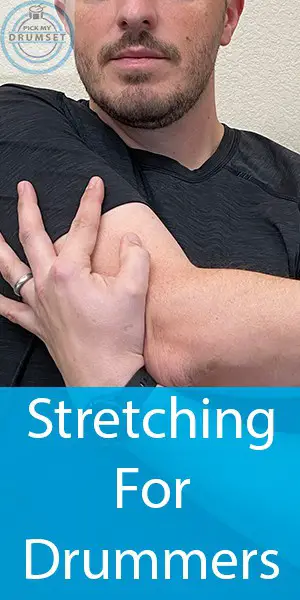
Stretching cold can just be downright dangerous as you can injure muscles which aren’t quite ready to be utilized in that way. Think of a rubber band that’s been left in the freezer for a few hours. You wouldn’t want to stretch it out right after you pull it out of the freezer. You’ll likely want to let it warm up a bit before you do so. The same principal applies here.
As for cooling down – no matter what activity you engage in (drumming, running, lifting weights, etc.), it is pretty much always a great idea to stretch your muscles out after the activity is done as to help relax any tension you have built up which will in turn let them heal and recover much more quickly.
Free PDF Quick Guide
OK – ready to incorporate this stretching routine into your daily drumming life? Great! To make it easy – I created a PDF quick guide that I’d love for you to have. This way, you won’t have to print this entire article or memorize the routine!
YouTube Video
Related Questions
What types of exercise can help improve my drumming?
Yoga is the most beneficial exercise for drummers because it incorporates a full body workout with stretching. In my experience, this helps you not only build muscle tone, but also keeps your muscles limber and increases stamina.
Can drumming cause tendonitis?
Yes, just like with any other sport or activity where you are repeatedly using certain parts of your body. Though carpal tunnel is more of a concern for drummers in general, swelling of the tendons (tendonitis) can be avoided by stretching and warming up and cooling down properly.
Disclaimer:
While my goal with this article is to be helpful, I am not a medical professional and therefore it does not constitute medical advice. You should consult your doctor about your particular situation.
